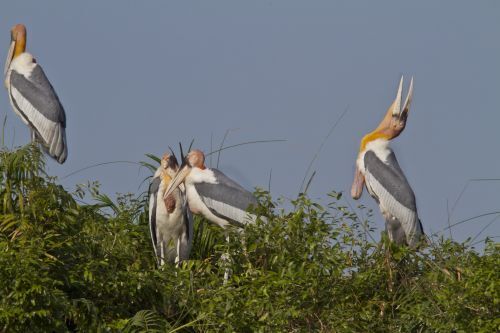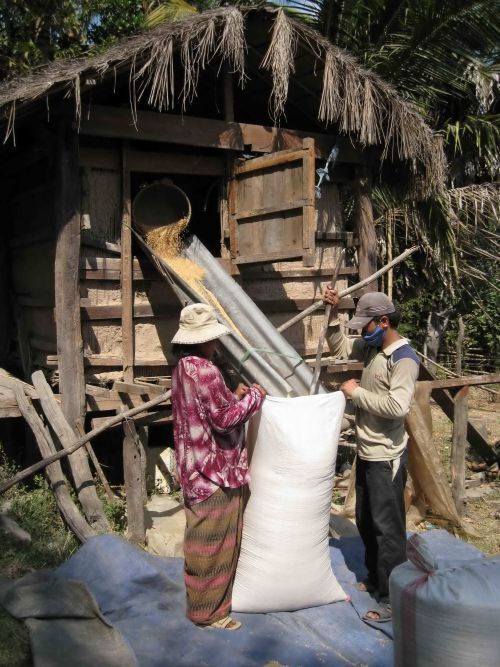
Eat Rice, Save Birds
Engaging Cambodian communities in conservation through financial incentives
17 December 2013
Cambodia supports globally important populations of wide-ranging, large-bodied bird species that are threatened by agricultural intensification and expansion, trade-driven hunting and chick/egg collection at nest sites. To address this problem of escalating biodiversity loss in the Northern Plains and Tonle Sap Lake and Floodplain and encourage community participation, the Wildlife Conservation Society (WCS) and partners designed a project with three financial incentive schemes.
With funding from CEPF provided through the Indo-Burma biodiversity hotspot investment, WCS expanded the project to new sites and species to improve the project’s long-term financial viability and to increase the role of local civil society partners.
The project had four components, three of which provided local communities with direct financial incentives to ensure that populations of the targeted globally threatened bird species were protected by:
- Implementing community-based ecotourism that links revenue directly to long-term species conservation at various sites in the Northern Plains, at the Ang Trapeang Thmor (ATT) Sarus Crane Reserve, and in the Bengal Florican Conservation Areas (BFCA).
- Developing wildlife-friendly farming schemes, including locally branded “Ibis Rice,” in the Northern Plains and the BFCAs. This initiative encourages farmers to engage in conservation by offering them a premium price for their rice (about 10 percent above otherwise market value) if they agree to abide by conservation agreements that are designed to protect the areas used by the Critically Endangered waterbirds and other globally threatened species.
- Supporting a birds’ nest protection program at Prek Toal Core Area of the Tonle Sap Biosphere Reserve where communities are offered financial incentives for protecting nests to reduce trade-driven hunting.
- The fourth goal aimed to increase the capacity among the three partner civil society organizations (CSOs) – the Sam Veasna Center for Conservation (SVC), Sansom Mlup Prey (SMP) and Centre d’Etude et développement Agricole Cambodgien (CEDAC) – which are integral to the operation of the financial incentive schemes.
Accomplishments
- Increased revenue for participating local communities – During the project, WCS worked closely with families from 25 villages and it is estimated that more than 20,000 community members have benefitted from the project’s activities.
All nine villages participating in the ecotourism program exhibited sustained growth in the numbers of tourists visiting the sites despite some dips due to the global economic problems. In Sambuor, the number of tourists increased by 32.5 percent from 2011-2012 to 2012-2013. The amount of revenue generated by these visitors also increased throughout the project term, and the village development funds accrued were used to construct a new road in the village. Other participating villages used the funds to build libraries and repair a pagoda.
The Ibis Rice scheme expanded to six additional villages, with the number of farmers involved rising from 12 in 2008-2009 to 216 in 2012-2013. Over the same period, the total amount of paddy purchased by the scheme has risen from 7.72 tonnes to 282.70 tonnes, causing the total annual benefit paid to participating farmers to increase from $1,325 in 2008-2009 to $7,908 in 2012-2013.
At Prek Toal, the birds’ nest protection program expanded from 12 community rangers in 2003 to 32 in 2013. In the Northern Plains, the program has benefited approximately 100 households each year and has protected 2,981 nests of 11 species, from which 5,379 chicks have fledged.
“The innovative mechanisms developed by WCS helped incentivize local people to conserve breeding populations of large waterbirds at key sites in northern Cambodia. In addition to successfully reducing threats to these species, the project also improved livelihoods of those who participated,” said Jack Tordoff, grant director with CEPF.
- Improved capacity in communities and CSOs – Throughout the project, WCS improved the capacity of 32 community-based organizations. Of the three local partner CSOs, SVC and SMP have both shown significant growth in various measures of enterprise development, with SVC managing all ecotourism promotion, guide training and bookings, and SMP providing buying, milling, packing and distribution services for Ibis Rice by the end of the project. SVC is now fully financially viable, and a significant portion of their revenue is reinvested in conservation management activities at the various project sites.
- Increased populations of some of the targeted globally-threatened birds – In Prek Toal, the Endangered greater adjutant (Leptoptilos dubius) increased by 157 percent from 2007 to 2012, from 77 nests to 198 nests; and the Vulnerable lesser adjutant (Leptoptilos javanicus) increased by 14 percent from 2007 to 2012, from 253 nests to 289 nests. In the Northern Plains, the Critically Endangered white-shouldered ibis (Pseudibi davisoni) increased from one nest in 2002 to seven in 2012.
Challenges
- Making a direct financial link between the economic well-being of the communities affected by the needs of conservation and the conservation objectives themselves – The project sought to further test the argument supporting financial incentive schemes for local communities to participate in conservation, to understand the mechanisms necessary and to overcome the difficulties involved. To encourage participation, the project allowed communities involved to have direct control over the services provided (tourism, rice production or nest protection), rewarded communities directly for the provision of those services, and linked continuing provision of financial incentives directly to a healthy conservation status.
- Motivating communities and encouraging positive behavior toward conservation – Constant contact with the communities was vital and should be a part of all community-based natural resource management projects. To achieve this, advisors and social mobilizers were employed and spent long periods of time on the ground with the local communities. This frequency of contact helped build high levels of trust, capacity and motivation, which in turn facilitated the change in people’s mindsets and behaviors and brought about the success of the three financial incentive schemes.
Keys to Success
- Using positive results to garner attention – Producing results successfully on the ground helped to draw the attention of senior politicians to the project’s aims. In fact, the senior minister for the environment became interested in the project after Tmatboey – a village participating in the ecotourism initiative – won the United Nations Development Programme Equator Prize in 2008. After making a visit to the village, the senior minister requested a further six sites to be identified and developed for nature-based tourism.
- Engaging the government – The close liaison between government, an international NGO, and national civil society was particularly successful in enabling the complex requirements of the activities to be met smoothly while providing the Ministry of Environment and the Forestry Administration with unique insights into the needs of the local people and examples of how to work with them to achieve important conservation goals. By empowering existing government management structures rather than creating parallel ones, the project appears to have been successful in developing effective government engagement, participation and motivation.
- Developing a replicable model to achieve sustainability – The project was designed to be part of a much longer process, with structures in place to support its planned achievements after its end since WCS and its partners will continue to implement the three financial incentive schemes.
“The structures that were in place prior to CEPF’s support were strengthened over the term of this project, and additional investment will allow further replication and enable sustainable conservation. Over the next five years, we plan to empower the community management committees to increase the extent to which they are involved in protected area management, increase local community incomes from conservation and in doing so, bring conservation interventions, such as ecotourism, Ibis Rice and the bird nest protection program to a point of financial and organizational sustainability,” said Tom Clements, director of the WCS Cambodia Program.
The three direct payment initiatives have all already been replicated at a small level, but the model can be used to expand the three financial incentive schemes to new villages within the current work areas or to new regions within Cambodia. This would help bring benefits to other globally threatened species as well as to new rural communities.
To learn more about this project, including recommendations on future activities and additional lessons learned, click here to view the final project evaluation.
About
Conserving a Suite of Cambodia’s Highly Threatened Bird Species
Purpose: Secure core populations of a suite of globally threatened bird species at four sites in Cambodia through a series of innovative conservation interventions focusing on providing direct incentives to local communities, namely payments for birds’ nest protection, improved value chains for “wildlife friendly” produce and ecotourism development. Strengthen the capacity of local organizations to engage in long-term conservation efforts for these species.
View the final project completion report.
Grantee
The Wildlife Conservation Society(WCS), founded in 1895, has the clear mission to save wildlife and wild places across the globe. WCS does so through science, global conservation, education and the management of the world’s largest system of urban wildlife parks, led by the flagship Bronx Zoo. Together these activities change attitudes toward nature and help people imagine wildlife and humans living in harmony. WCS is committed to this mission because it is essential to the integrity of life on Earth.
Contact: Tom Clements, director, WCS – Cambodia Program